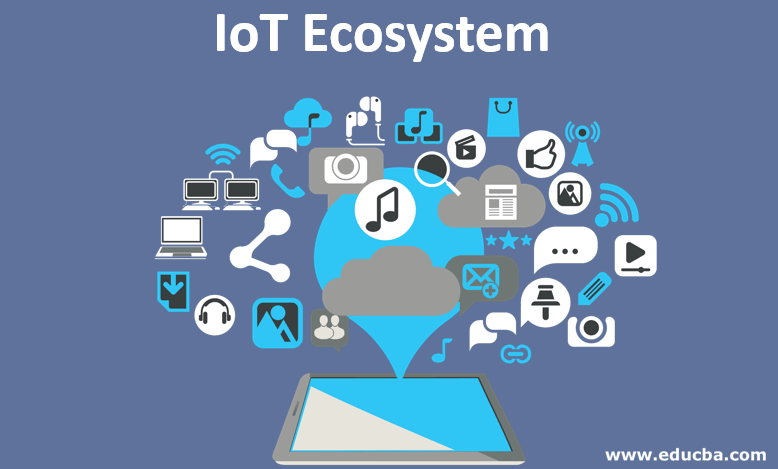Updated August 10, 2023
Introduction to IoT Ecosystem
An IoT Ecosystem is a combination of various IoT layers beginning from the user layer to the connectivity layer. Industry grade IoT ecosystems consist of various architectural components like hardware components, software, and analytical components connectivity layers, etc. In practice, it is not easy to define the generic architecture of an IoT ecosystem as it varies from business to business. Here we will try to generalize the components for an IoT infrastructure based on which an ecosystem is built upon.
Components of an IoT Ecosystem
In a typical IoT ecosystem, end-user components like smart devices, sensors, third party components are connected to the compute engines or cloud instances through the internet or intranet. Let us look at the various modules of it.
1. Sensing and embedding components
We incorporate temperature, gyroscope, pressure, light sensors, GPS, Electrochemical, Gyroscope, RFID, etc. to acquire data based on a particular use case. For example for automotive use cases, we use Light detection sensors along with pressure, velocity and imagery sensors. Choosing the right sensing components is a key step for a successful use case.
2. Connectivity Layer
An important aspect of the IoT environment is connectivity. Without seamless connectivity between IoT sensors, end devices, and analytics or computing components, we cannot execute a use case. Let us list down the various modules of connectivity layers
- Protocols: IoT applications can be based on both the internet and intranets. For internet applications TCP/IP, based architecture is generally followed. For Intranet IoT use cases, devices are connected using LAN, RF, Wi-Fi, and Li-Fi, etc.
- Gateway: Gateways are an important component to manage the internet traffic between IoT devices and connected networks. For any end to end IoT use case it is very important to maintain the security. Level Five Gateways are useful to maintain and monitor the traffic. It can block the particular IP addresses, protocols, even application layers components.
3. Analytics Layer
In almost every IoT use case, the data is used to derive important business insights and drive business decisions. We use predictive learning/ deep learning-based models on this huge data to obtain insights. The raw analog signals are preprocessed and converted to a format on which machine-learning models are developed. We choose a big data infrastructure based on the use case.
4. Data Management Layer
Industry grade IIoT solutions require acquiring, managing and manipulating large scale raw and processed data. Generally, cloud-based architectures are used to serve the purpose based on business needs. Very large scale organizations, capable of handling large scale data (as huge as petabytes per second) often set up their own data centers to manage this.
5. Edge IT
Edge IT is the consolidated architecture of software and hardware gateways to preprocess raw data. Edge IT solutions are used to collect the raw data from sensors, RFID, electromechanical components and do the necessary transformation before sending it to the cloud servers. They also come with local storages, which is used as a buffer for the data pipeline before the transformation.
6. End Components
Smart devices like smartphones, tablets, PDA, etc. serve as the end components of an IoT ecosystem. These devices are connected to the IoT computational engine through cloud applications and remote connectivity is established on demand. In some cases, the computational engine is integrated into third-party UI components, services or served as a component of the parent ecosystem.
Diagrammatically we can provide a high-level design of the IoT ecosystem as follow
End to End IoT Solution providers
In the era of cheap computation and early increments of IoT, a large number of technology organizations and startups are involving into the end-to-end IoT solutions.
Let us list down some of the top IoT solution providers and their businesses
- VATES: It deals with end-to-end multi-platform, fully integrated IoT applications and integration.
- Augury: It provides mechanical diagnostics IoT solutions
- Bastille: It provides IoT based security and surveillance ecosystems
- FogHorn: foghorn provides Industry grade Edge IT solutions
- Hologram: It offers cloud-based end to end cellular connectivity and device management solutions
Conclusion
In this article, we have discussed the high-level architecture of an IoT ecosystem and the global providers of end-to-end IoT ecosystems. In the industry landscape, the definition of the IoT ecosystem and standards are still an evolving field of study. Based on the target industry, type of use case, budget the ecosystem differs a lot. One of the main aspects of the Industrial IoT solution is the balance between expectation and engagement scale.
Recommended Articles
This is a guide to IoT Ecosystem. Here we discuss the Components of IoT Ecosystem with the various modules and End to End IoT Solution providers. You may also look at the following article to learn more –


